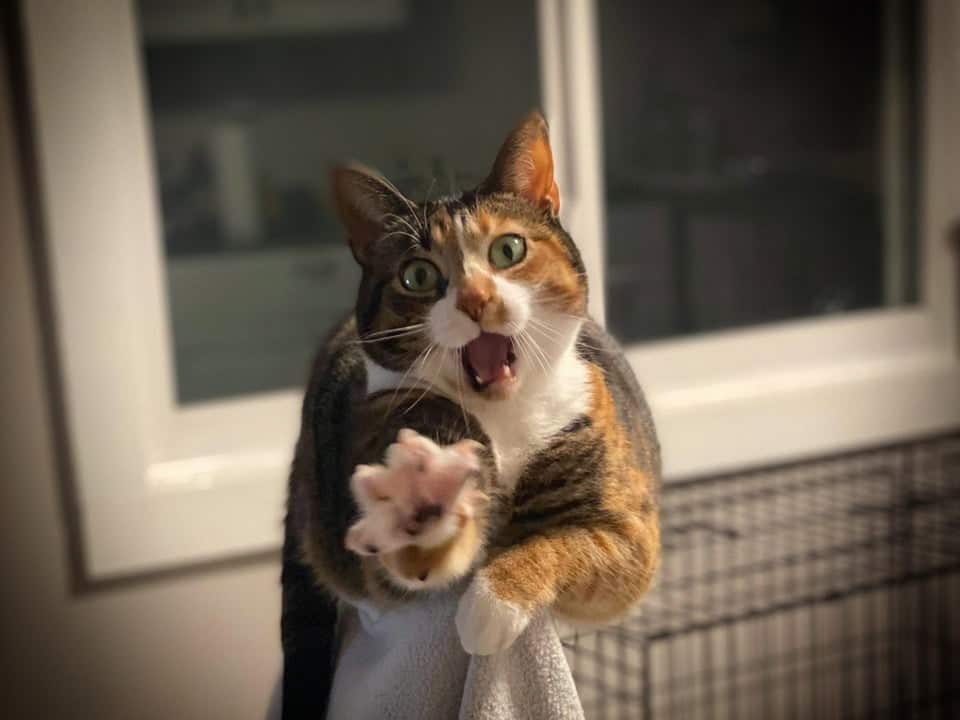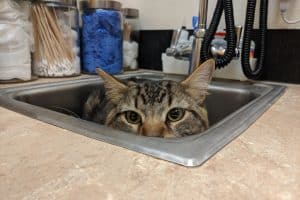Does the mere thought of taking your cat to the vet fill you with dread? You’re not alone. Vet visits can be stressful and overwhelming for both cats and their owners.
But did you know that a stressful vet visit can actually have negative effects on your cat’s health? Cats, like humans, can experience physical and psychological symptoms of stress, which can compromise their immune system and increase their risk of illness.
However, with a little preparation, you can make the experience much more pleasant for your feline friend, and help keep them healthy and happy.
In this post, we’ll explore the importance of preparing your cat for a vet visit with practical tips for helping your cat stay calm and relaxed during their next vet visit.

Signs of a Stressed Cat
Recognizing your cat’s stress signals can help you identify the source of their stress and take steps to alleviate it. This can help prevent negative health outcomes, such as compromised immune systems, and improve your cat’s overall quality of life.
Cats can display physical, behavioral, or emotional stress signals. Some common stress signals that occur during a vet visit include:
- Hiding or avoidance
- Excessive vocalization
- Changes in eating or drinking habits
Remember that each cat is unique, and stress signals can manifest differently in cats. Additionally, stress-causing situations can vary from cat to cat. For example, some cats may become stressed during car rides, while others may find visits to the vet more stressful.
Understanding these common stress signals and knowing your cat’s unique needs can help reduce their stress levels and improve their overall health and well-being. If left unchecked, stress can lead to negative health outcomes and compromise your cat’s immune system.
How to Prepare Your Cat for a Vet Visit
Going to the vet can be a stressful experience for cats, but there are steps you can take to make it a more comfortable and positive experience. Here are some tips to help you prepare.
Before the Vet Visit
Introduce your cat to their carrier well in advance of the appointment. Leave the carrier out in a comfortable area and place treats or toys inside to encourage your cat to explore and feel comfortable inside. For example, you can leave a catnip toy or some treats inside the carrier. Don’t try to force your cat into the carrier.
Note:
Familiarize your cat with car travel by taking them on short, low-stress trips in the carrier. Gradually increase the length of the trips to help your cat feel more at ease.
For example, you can take your cat on a short car ride to a park or a friend’s house. This will also help in getting your cat accustomed to car rides when you decide to go for a trip.
Common mistake:
Prepare for the vet visit itself. Call ahead to the vet clinic to ask about their protocols for cat visits. Some clinics may have separate waiting areas or rooms for cats, which can help reduce stress. On the day of the appointment, bring familiar items from home, such as a favorite toy or blanket, to help your cat feel more at ease in the unfamiliar environment.
Ensure to schedule the appointment during off-peak hours if possible. A quieter clinic can make the experience less overwhelming for your cat.
Tip:
Remember, every cat is unique and may require different approaches to help them feel comfortable and calm during a vet visit. By taking the time to prepare your cat in advance and providing a stress-free environment, you can help make the experience a positive one for both you and your feline friend.
At the Vet Clinic
- Bring familiar items from home, such as a favorite toy, blanket, or towel with your scent on it, to help your cat feel more at ease in the unfamiliar environment. Cover the carrier with a towel or blanket during transport to the vet clinic. This can help reduce visual stimuli and make your cat feel more secure during the car ride.
- Consider using a pheromone spray or diffuser on a towel or blanket, such as Feliway, to help reduce stress and anxiety in your cat. Avoid using it too close to your cat’s face, which can cause respiratory problems.
- Speak calmly and softly to your cat during the visit, and provide positive reinforcement with treats or praise whenever they remain calm. For example, give your cat a treat after each successful step of the exam. Avoid scolding or punishing your cat as it can increase stress and make the experience more negative.

If Your Cat is Nervous or Anxious
Try to remain calm and patient with your cat. Rushing or forcing your cat to do something they’re uncomfortable with can increase stress. Try to wait patiently for your cat to come out of the carrier on their own.
Tip:
Consider using natural remedies a few hours before the vet visit to help reduce anxiety. You can try calming supplements or herbal remedies but try not to give your cat too much of it, as it can cause adverse effects.
For specific examples of calming supplements and herbal remedies for cats, you can try:
- Bach Rescue Remedy for Pets
- Zylkene
- Composure Pro Chews
- Solliquin
- Adaptil for cats
While most of these remedies are generally safe, it’s always best to consult with a veterinarian before use regarding potential side effects and risks. Some of them may have adverse effects on certain cats or interact negatively with other medications.
Important:
If necessary, talk to your vet about prescription medications to help calm your cat during the visit. Your vet may prescribe a sedative to help your cat relax during the exam.
Gabapentin, Alprazolam, Trazodone, and Acepromazine are prescription medications that can help calm cats before a vet visit.
When used correctly and under the supervision of a veterinarian, these medications are generally considered safe for cats. However, they carry some risks and potential side effects, so following dosing instructions carefully and monitoring your cat’s behavior closely is important.
After a vet visit, create a ‘de-stress zone’ at home. This could be a quiet room with their favorite bed, a couple of toys, and dimmed lights. It’s a dedicated space for them to retreat and relax after the vet ordeal.
Calming Techniques
Calming techniques can help reduce stress and anxiety in cats during a vet visit or any other stressful situation. Here are some common types of calming techniques that you can use:
- Massage Therapy. Massaging your cat’s muscles can help them relax and reduce tension. Start by gently rubbing your cat’s shoulders and neck, then work down their back.
- Music Therapy. Playing soothing music can help calm your cat’s nerves and reduce anxiety. Soft, classical music is often recommended, but you can also try playing nature sounds or music designed for pets.
- Acupressure (should only be done by a professional). Acupressure is a traditional Chinese medicine technique that involves applying pressure to specific points on the body to alleviate pain and reduce stress. It works by applying pressure to the following points on your cat’s body:
- The base of the ears
- The top of the head
- The spine
- The area between the eyes
Important:
- Aromatherapy. Using essential oils can help relax your cat and reduce stress. Some popular calming scents for cats include lavender, chamomile, and valerian.
- Calming Clothing. Some types of clothing, such as compression shirts or vests, can help reduce cat stress and anxiety. These clothing items provide gentle pressure to your cat’s body, similar to a comforting hug.
By implementing these calming techniques, you can help reduce your cat’s stress and anxiety during a vet visit, and improve their overall well-being.
What to Expect During a Vet Visit
Here are some steps you can expect during a typical vet visit, with tips on how to keep your cat calm:
Check-In
On arrival, be ready to share your cat’s medical history and discuss their health status. Maintain a soothing tone of voice to create a sense of calm for your cat.
Waiting Period
keep your cat calm by providing them with familiar items from home, such as a favorite toy or blanket. Avoid letting them interact with other animals in the waiting room, as this can cause stress and anxiety.
Examination Phase
The vet will monitor your cat’s vital signs, conduct a thorough body check, and proceed with any necessary tests. Your calming voice and rewarding treats can provide a comfort to your cat during this stage.
Your cat may need vaccinations or medication during the visit. To keep your cat relaxed during this process, remain calm, speak softly, and provide positive reinforcement with treats or praise.
Check-Out
After the visit, the veterinarian will inform you about your cat’s health and any necessary follow-up care. To keep your cat calm during check-out, maintain a sense of calm and avoid rushing. Take your time gathering any information or materials you need, and move slowly and gently around your cat
After the Vet Visit
It’s important to help your cat recover after a vet visit to ensure they have a positive experience and feel comfortable visiting the vet in the future. Here are some tips to help your cat recover after a vet visit.
Give your cat time and space to recover, as your cat may feel tired and want to rest. Provide a quiet and comfortable space for your cat to rest without being disturbed. Offer a cozy bed or blanket for added comfort
Keep an eye on your cat’s behavior and health after the visit. If you notice any unusual behavior or symptoms, contact your veterinarian.
Follow any post-visit care instructions, such as medication or follow-up appointments. Be sure to follow these instructions carefully. If you need to schedule a follow-up appointment, mark it on your calendar to ensure you don’t forget.
Reinforce positive experiences by offering treats, praise, or playtime with your cat. This can help your cat associate the vet visit with positive experiences.
Happy Cat, Happy Life
As pet owners, it’s our responsibility to prioritize the health and well-being of our feline friends, even if it means dealing with their dislike of the vet. By following the tips we’ve shared and taking the necessary precautions, we can ensure that our cats receive the care they need while minimizing their discomfort. Remember, a calm and relaxed cat is a healthy cat.
With proper preparation, such as bringing familiar items and using pheromone products, you can help reduce stress and anxiety in your feline friend. Remember to speak calmly and provide positive reinforcement during the visit to encourage calm behavior. By following these tips, you can make the vet visit a positive experience for both you and your cat.
Alex, a passionate animal lover, has experience in training and understanding animal behavior. As a proud pet parent to two dogs and three cats, he founded AnimalReport.net to share insights from animal experts and expand his knowledge of the animal kingdom.




